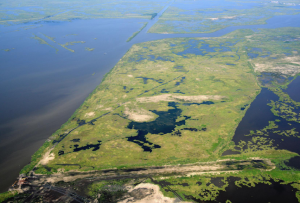Eustis Engineering Services, L.L.C.’s Glen Andersen, ScD, P.E., spoke about a technical topic related to preserving the Louisiana coast at the Geotechnical & Structural Engineering Congress in Phoenix, Arizona, on 15 February. The title of his talk was “Use of Density and Moisture Content Measurements to Predict the Settlement of Peat Deposits in Coastal Environments.”
Dr. Andersen spoke about a procedure for estimating the settlement of peat for marsh creation projects. Because peat is highly organic and fibrous, it behaves differently than the inorganic soils typically tested. Peat is highly compressible and may complicate engineering.
Dr. Andersen and two of his Eustis Engineering colleagues, Jim Hance, P.E., and Karishma Desai, P.E., have used the technique on several south Louisiana marsh projects in the past six months. Instead of using the conventional one-dimensional consolidation laboratory test to estimate settlement, Dr. Andersen and his colleagues measured the properties of peat in the laboratory. Then they used these physical properties to estimate peat’s response to surficial loading.
“Instead of testing small pieces, the field itself is the lab,” Andersen said.
This issue is of particular importance to Louisiana because marshes are vital to coastal protection, especially during hurricanes. Marshes are created by pumping dredged material through pipelines. The amount of dredged material needed to recreate marsh is difficult to estimate. If the amount of dredged material needed is over-estimated, the project will be estimated to be too costly and will not get funded. If the amount of dredged material needed is under-estimated, the habitats will be left unprotected from freshwater and marsh will be lost sooner.
The Geo-Institute (G-I) and Structural Engineering Institute (SEI) of the American Society of Civil Engineers (ASCE) hosted the conference.


